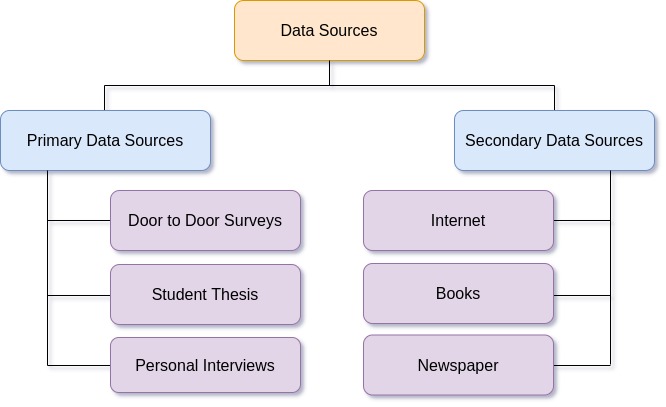Sources of Data
As we have discussed, there are two data sources, Primary and Secondary.

Primary Data Sources:
Data which is being collected for the first time and it is being collected from the raw sources (from the origin) itself.
- Door to Door Surveys: Officials reach out Door to Door and do surveys to collect Data. For E.g. Census Data is collected every 10 years in India to understand the population and other demographic aspects
- Student Thesis: Thesis written by researchers, students are the primary data sources. They perform research in particular streams and come up with new theories and results.
- Personal Interviews: Conducting one-to-one interviews helps us in collecting data. Interviews can be online or offline where few questions will be asked by the interviewer from the interviewee and his/her opinion is noted down. These interviews help in understanding the audience so that companies can improve their products.
Advantages of Primary Data Sources:
- Data is trustworthy
- Data collected is inlined with the requirement
Disadvantages of Primary Data Sources:
- Data collection is a time-consuming process
- It is Expensive
Secondary Data Sources:
Data that is not being collected for the first time. It is where we are relying on existing data sources, where the data has already been collected in the past through primary sources.
1. Internet: The Internet is a major source for secondary data sources these days. A huge amount of data gets uploaded by researchers, communities, agencies, government, etc.
This uploaded data can be used for analysis/decision/presentation purposes.
2. Books and Newspapers: Books and Newspapers are available online and offline and provide a rich source of information.
Newspapers are written with the news collected by journalists, where a journalist performs the primary method of data collection:
- by reaching out to the sites where incidents have happened,
- by interviewing the witnesses,
- by understanding the situation,
- by noting down the facts and figures found at the site etc.
Similarly, books are written by authors either through their primary knowledge or they take the help of other available data sources.
Advantages of relying on Secondary Data Sources:
- A wide range of data is available
- Data collection is fast
- Cheap
Disadvantages of relying on Secondary Data Sources:
- Data may not be trustworthy.
- Data can be stale/outdated.
We collect cookies and may share with 3rd party vendors for analytics, advertising and to enhance your experience. You can read more about our cookie policy by clicking on the 'Learn More' Button. By Clicking 'Accept', you agree to use our cookie technology.
Our Privacy policy can be found by clicking here